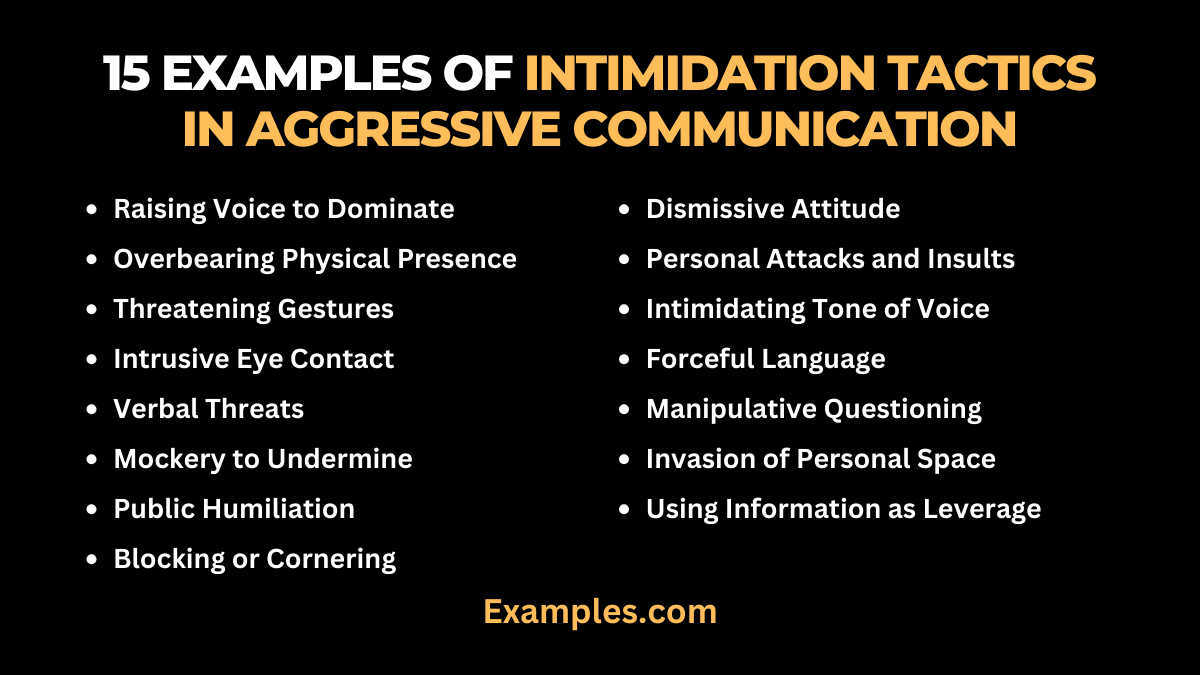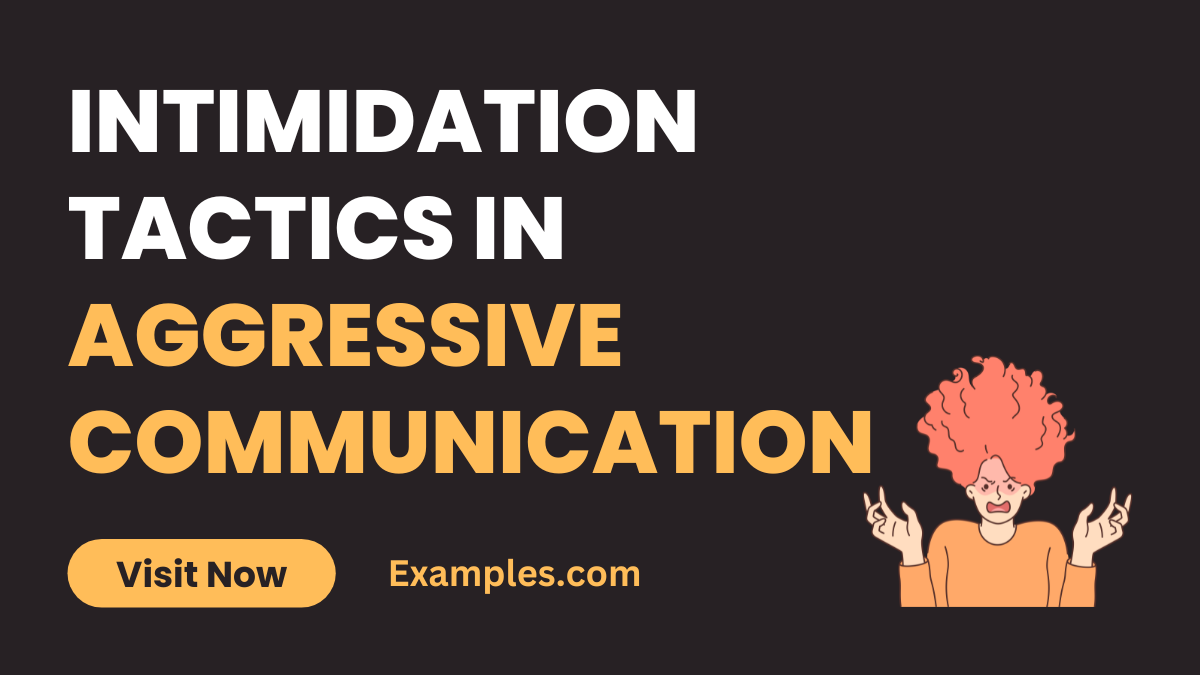14+ Intimidation Tactics in Aggressive Communication Examples
Explore the intricate world of Intimidation Tactics in Aggressive Communication through this detailed guide. Packed with Aggressive Communication Examples, it sheds light on the various forms of intimidation used in aggressive interactions, their impact, and how to effectively respond. Whether in personal relationships or professional environments, understanding these tactics is key to maintaining respectful communication and preventing conflicts. This guide provides practical sentence examples and strategies to navigate through intimidation in aggressive scenarios.
What is Intimidation Tactics in Aggressive Communication?

Intimidation tactics in aggressive communication involve using words, tone, body language, or actions to scare, control, or force someone into doing something. These tactics are a form of aggressive behavior where the speaker tries to dominate or influence others by making them feel afraid or less confident. It’s a way of communicating that can make the person on the receiving end feel threatened or uncomfortable.
15 Examples of Intimidation Tactics in Aggressive Communication
Intimidation tactics in Aggressive Communication play a significant role in shaping interactions, often leading to unhealthy and unproductive outcomes. This guide provides 15 examples of such tactics, demonstrating how they manifest in various communication scenarios. Each example highlights a specific form of intimidation, offering insights into how it operates and affects the dynamics of conversation. Understanding these examples is crucial for anyone looking to identify, respond to, and mitigate aggressive and intimidating behaviors in both personal and professional contexts.

- Raising Voice to Dominate: Elevating voice volume aggressively to overpower others in a conversation. This tactic can silence opposing views and create a climate of fear, hindering open discussion.
- Overbearing Physical Presence: Using physical size or stature to intimidate others during a discussion. This can include standing too close or looming over someone, making them feel physically threatened.
- Threatening Gestures: Employing gestures like clenched fists, finger-pointing, or aggressive posturing to imply a threat. These non-verbal cues can escalate tension and imply physical harm.
- Intrusive Eye Contact: Staring intensely or glaring at someone to intimidate. This can be particularly disconcerting and is used to dominate and control the flow of conversation.
- Verbal Threats: Making explicit or veiled threats of harm, reprisal, or negative consequences. These threats can be used to coerce compliance or silence dissent.
- Mockery to Undermine: Sarcastic remarks or mocking tone used to belittle someone’s opinions or contributions, often in front of others, to undermine their confidence and stature.
- Public Humiliation: Criticizing or shaming someone in a public setting. This tactic can diminish the individual’s credibility and self-esteem, exerting control through embarrassment.
- Blocking or Cornering: Physically impeding someone’s movement or cornering them during an argument. This can create a sense of entrapment and heighten anxiety.
- Dismissive Attitude: Showing blatant disregard for someone’s thoughts, feelings, or contributions. This tactic invalidates the other person’s perspective and establishes a power imbalance.
- Personal Attacks and Insults: Targeting an individual’s character, abilities, or personal attributes to demean them. These attacks can be damaging to self-esteem and workplace morale.
- Intimidating Tone of Voice: Using a harsh, loud, or menacing tone to dominate conversations. This can be particularly effective in silencing opposition and establishing authority.
- Forceful Language: Utilizing assertive, commanding language to exert control in a conversation. This can involve demands, ultimatums, or aggressive questioning.
- Manipulative Questioning: Posing leading or loaded questions to trap the respondent or put them on the defensive. This tactic can be used to steer conversations and discredit the other person.
- Invasion of Personal Space: Deliberately standing or leaning too close during a conversation to exert dominance. This invasion can be unsettling and is a clear display of power.
- Using Information as Leverage: Exploiting confidential or sensitive information about someone to gain an upper hand. This can involve threats of exposure or using known vulnerabilities against someone.
Aggressive Communication Intimidation Tactics in Relationships
Intimidation tactics in relationships, under the umbrella of Aggressive Communication, can severely impact the dynamics of personal interactions. This segment explores ten distinct examples of such tactics, each underscoring how aggression can manifest in close relationships. From subtle manipulation to overt threats, understanding these patterns is crucial for recognizing and addressing unhealthy communication. This guide is essential for anyone seeking to foster healthier, more respectful, and supportive personal relationships.
- Constant Criticism: Continuously finding fault in a partner’s actions or words.
Example: A partner regularly criticizes the other’s choices or opinions, undermining their confidence. - Threatening to Leave: Using the threat of abandonment or break-up as a control mechanism.
Example: During arguments, one partner repeatedly threatens to end the relationship, creating a sense of insecurity. - Jealousy as a Tool: Exhibiting excessive jealousy to control or restrict a partner’s actions.
Example: A partner displays extreme jealousy, questioning every interaction with others to exert control. - Financial Control: Using money as a means to exert power and control in the relationship.
Example: One partner takes complete control over finances, limiting the other’s access to money. - Isolation from Friends and Family: Actively discouraging or forbidding contact with close ones to increase dependency.
Example: A partner insists the other to cut ties with friends, increasing their isolation. - Emotional Blackmail: Manipulating a partner’s feelings to get what they want.
Example: A partner uses guilt or emotional appeals to manipulate the other into compliance. - Public Belittlement: Humiliating or belittling the partner in public settings.
Example: During social gatherings, one partner makes disparaging remarks about the other.
Decoding Intimidation Tactics in Aggressive Communication
Decoding intimidation tactics in Aggressive Communication is crucial for understanding and addressing the underlying power dynamics in various interactions. This segment provides an in-depth look at ten different intimidation tactics, illustrating how they can subtly or overtly influence and control conversations. From professional environments to personal relationships, recognizing these tactics is key to fostering more equitable and respectful communication.
- Overly Authoritative Language: Using commanding language to assert dominance.
Example: A manager uses imperatives and authoritative tone in every directive, stifling discussion or input. - Intense Interrogation: Bombarding someone with questions to intimidate or control the conversation.
Example: During a meeting, one person aggressively questions a colleague, not allowing them to explain. - Invalidating Opinions: Systematically dismissing or invalidating others’ viewpoints.
Example: In discussions, a team leader consistently dismisses ideas that are not their own. - Leveraging Professional Power: Using one’s position or rank to intimidate others into compliance.
Example: A senior employee threatens junior staff with negative performance reviews if they dissent. - Withholding Information as Control: Intentionally keeping vital information to maintain an upper hand.
Example: In a team project, one member withholds crucial data, making others dependent on them. - Negative Rumormongering: Spreading malicious rumors to undermine someone’s credibility.
Example: A coworker spreads unfounded rumors to damage another’s reputation in the office. - Excessive Competitiveness: Turning every interaction into a competition to dominate.
Example: A colleague approaches all tasks as contests, putting undue pressure on peers.
What are Common Intimidation Tactics Used in Aggressive Communication?
Intimidation tactics in aggressive communication are a set of behaviors and methods designed to instill fear, exert control, or dominate others. These tactics are prevalent in various communication settings and can significantly impact the dynamics of interactions. This guide provides an in-depth look at the common intimidation tactics used in aggressive communication, helping readers recognize and understand these behaviors for better handling and response.
- Yelling and Loudness: Raising the voice to an extreme level to overpower the listener and assert dominance.
- Threatening Language or Gestures: Using words or actions that imply harm or negative consequences to pressure the other person.
- Overbearing Body Language: Exhibiting physically dominant postures, like standing too close or towering over someone, to create discomfort.
- Constant Interruptions: Repeatedly cutting off the other person mid-sentence to undermine their point and take control of the conversation.
- Direct Verbal Attacks: Insulting, belittling, or using derogatory language to demean the other person.
- Sarcasm and Mockery: Employing a mocking tone or sarcastic remarks to belittle or invalidate someone’s opinions or feelings.
- Gaslighting: Manipulating someone into questioning their own memory or perceptions to gain psychological advantage.
- Public Humiliation: Deliberately embarrassing or shaming someone in a group or public setting.
- Withholding Information: Intentionally keeping crucial information to manipulate or control the outcome of a situation.
- Excessive Criticism: Constant fault-finding or nitpicking to erode the other person’s confidence and self-esteem.



